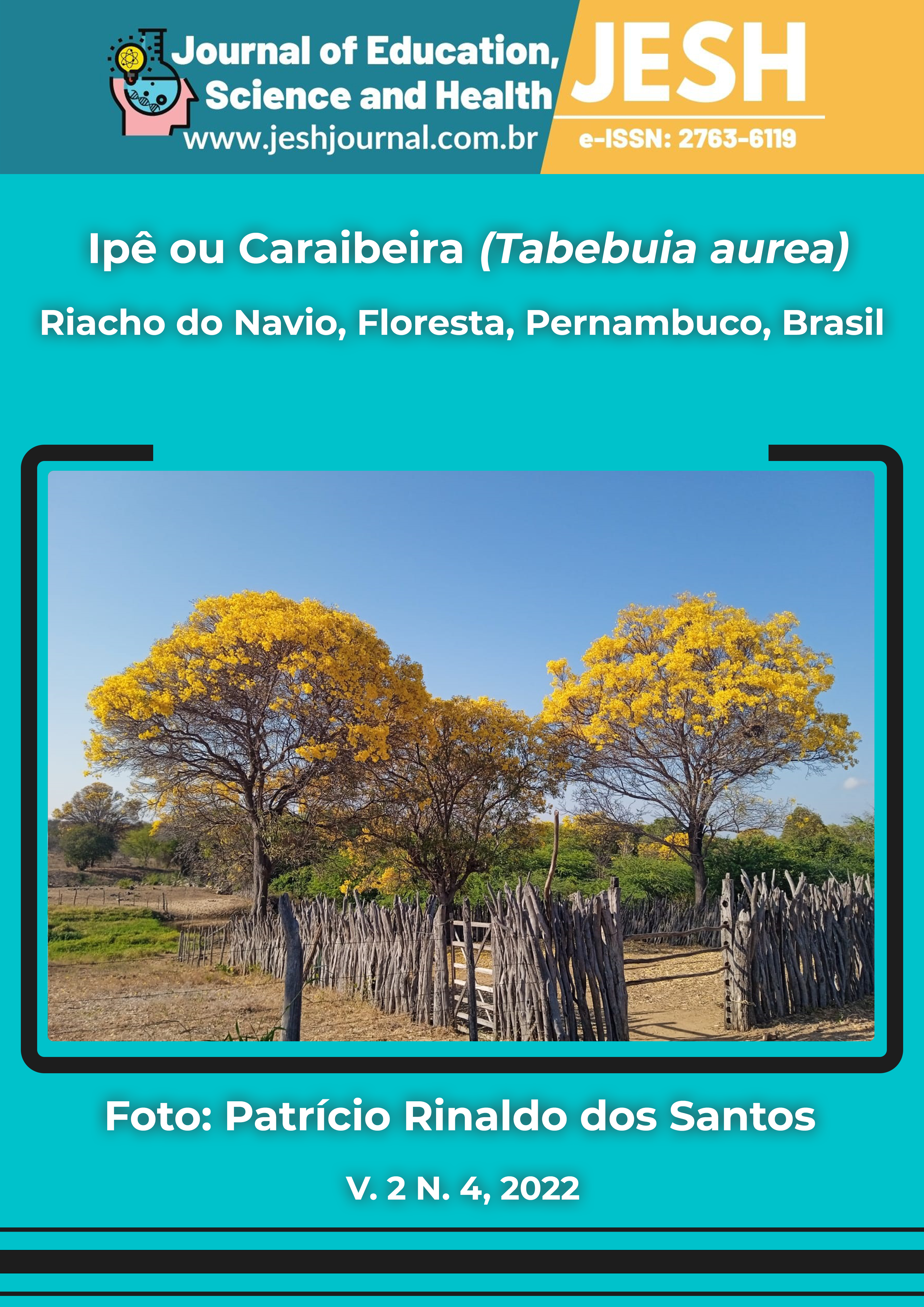EFFECTIVENESS OF CONVENTIONAL PHOTOTHERAPY COMPARED TO OTHER TYPES OF PHOTOTHERAPY IN THE TREATMENT OF NEONATAL HYPERBILIRUBINEMIA: INTEGRATIVE REVIEW
DOI:
10.52832/jesh.v2i4.153Keywords:
Phototherapy. Hyperbilirubinemia. Jaundice. Neonates.Abstract
Considering the relevance and application of phototherapy in the treatment of hyperbilirubinemia in newborns, this article sought to describe the effectiveness of types of phototherapy for neonatal hyperbilirubinemia compared to conventional phototherapy. The present work is an integrative literature review. The searches were carried out in the scientific electronic databases Biblioteca Virtual em Saúde Brasil (BVS), the U.S. National Library of Medicine (PubMed) and Google Scholar. The surveys were updated until September 2022, to check for a possible new study published on the researched topic. To guide the search, the Descriptors in Health Sciences (DeCS) and Medical Subject Headings (MeSH) were applied. Studies that contained the descriptors in the title, abstract and keywords were selected. The Boolean operators "AND" and "OR" were used, as well as parentheses to facilitate the search for manuscripts. It was concluded that some types of phototherapy, such as circumferential, fiber optic and reflective materials, showed more effective results when compared to conventional phototherapy. While intermittent, home, phototherapy together with KMC and phototherapy plus zinc sulfate were not statistically significant when compared to conventional. One study found that intensive phototherapy, compared to conventional, significantly reduces the need for exchange transfusion. Conventional phototherapy, when compared to fiberoptic, dual and combined phototherapy, was less effective in reducing bilirubin levels. Two studies showed divergence in relation to LED light when compared to conventional phototherapy.
Downloads
Metrics
References
Carvalho, D. V., Borges, E. L., & Pereira, J. T. (2017). Evidências no uso de fototerapia convencional em neonatos com icterícia. Nursing (Säo Paulo), 1827-1830.
Goudarzvand, L., Dabirian, A., Nourian, M., Jafarimanesh, H., & Ranjbaran, M. (2019). Comparison of conventional phototherapy and phototherapy along with Kangaroo mother care on cutaneous bilirubin of neonates with physiological jaundice. The Journal of Maternal-Fetal & Neonatal Medicine, 32(8), 1280-1284. https://doi.org/10.1080/14767058.2017.1404567 DOI: https://doi.org/10.1080/14767058.2017.1404567
Gottimukkala, S. B., Sethuraman, G., Kitchanan, S., & Pathak, S. (2021). Comparison of efficacy, safety & satisfaction of intermittent versus continuous phototherapy in hyperbilirubinaemic newborns≥ 35week gestation: A randomized controlled trial. The Indian Journal of Medical Research, 153(4), 446. https://doi.org/10.4103/ijmr.IJMR_2156_18 DOI: https://doi.org/10.4103/ijmr.IJMR_2156_18
Huallcca, C. J. U. & Medrano, K. B. E. (2017). Eficacia de la fototerapia Led comparado con la fototerapia convencional para acelerar la reducción de los niveles de bilirrubina en neonatos con ictericia. (Trabajo académico para optar el título de especialista, Universidad Privada Norbert Wiener). http://repositorio.uwiener.edu.pe/handle/123456789/1304
Iskander, I., Abdelmonem, S., El Houchi, S., Mandour, I., & Aly, H. (2021). Intensive phototherapy and oxidant-antioxidant status in infants with jaundice. Early Human Development, 161, 105465. https://doi.org/10.1016/j.earlhumdev.2021.105465 DOI: https://doi.org/10.1016/j.earlhumdev.2021.105465
Joel, H. N., Mchaile, D. N., Philemon, R. N., Mbwasi, R. M., & Msuya, L. (2021). Effectiveness of fiberoptic phototherapy compared to conventional phototherapy in treating hyperbilirubinemia amongst term neonates: a randomized controlled trial. BMC pediatrics, 21(1), 1-9. https://doi.org/10.1186/s12887-020-02458-2 DOI: https://doi.org/10.1186/s12887-020-02458-2
Mendes, K.D.S, Silveira, R.C.D.C.P, & Galvão, C.M. (2019). Uso de gerenciador de referências bibliográficas na seleção dos estudos primários em revisão integrativa. Texto & Contexto-Enfermagem, 28. https://doi.org/10.1590/1980-265X-TCE-2017-0204 DOI: https://doi.org/10.1590/1980-265x-tce-2017-0204
Montealegre, A., Charpak, N., Parra, A., Devia, C., Coca, I., & Bertolotto, A. M. (2020). Efectividad y seguridad de 2 dispositivos de fototerapia para el manejo humanizado de la ictericia. In Anales de Pediatría (Vol. 92, No. 2, pp. 79-87). Elsevier Doyma. https://doi.org/10.1016/j.anpedi.2019.02.008 DOI: https://doi.org/10.1016/j.anpedi.2019.02.008
Norabuena, E. L. G, & Huamán, J.S. (2019). Eficacia de la fototerapia comparada con la fototerapia más sulfato de zinc para disminuir los niveles de bilirrubina en neonatos con ictericia. (Trabajo académico para optar el título de especialista en enfermería en salud y desarrollo integral infantil, Universidad Privada Norbert Wiener). http://repositorio.uwiener.edu.pe/handle/123456789/2849
Noureldein, M., Mupanemunda, G., McDermott, H., Pettit, K., & Mupanemunda, R. (2021). Home phototherapy for neonatal jaundice in the UK: a single-centre retrospective service evaluation and parental survey. BMJ paediatrics open, 5(1). http://dx.doi.org/10.1136/bmjpo-2021-001027 DOI: https://doi.org/10.1136/bmjpo-2021-001027
Pontes, J. D. A. S., Gómez, S. L., de Fátima Turchiello, R., & Agostini, E. (2020). Desenho e análise de uma fonte de luz LED para aplicações em Fototerapia. Revista Brasileira de Física Tecnológica Aplicada, 7(2). https://doi.org/10.3895/rbfta.v7n2.12551 DOI: https://doi.org/10.3895/rbfta.v7n2.12551
Tovar, K. M. P, & Azúa, K. A. V. (2018). Eficacia de la Fototerapia como tratamiento de la Hiperbilirrubinemia en neonatos con incompatibilidad ABO atendidos en el Hospital Teodoro Maldonado Carbo desde el año 2013 al 2016. (Trabajo de titulación previo a la obtención del título de médico, Universidad Católica de Santiago de Guayaquil). http://repositorio.ucsg.edu.ec/handle/3317/11416
Uitz, S. M., Martínez, N. H., & Poot, G. J. M. (2022). Efectividad de la fototerapia con luz led para disminuir hiperbillirrubinemia neonatal en pacientes críticos. Revista Salud y Bienestar social, 6(1), 79-88.
Van Rostenberghe, H., Ho, J. J., Lim, C. H., & Abd Hamid, I. J. (2020). Use of reflective materials during phototherapy for newborn infants with unconjugated hyperbilirubinaemia. Cochrane Database of Systematic Reviews, (7). https://doi.org/10.1002/14651858.CD012011.pub2 DOI: https://doi.org/10.1002/14651858.CD012011.pub2
Yang, F., Liu, Y., Zheng, F., Yao, Q., & Mo, W. (2022). Efficacy of Circumferential Intensive Phototherapy in Treating Neonatal Hyperbilirubinemia: A Pilot Study. American Journal of Perinatology, 39(04), 425-428. https://doi.org/10.1055/s-0040-1717069 DOI: https://doi.org/10.1055/s-0040-1717069
Downloads
Published
How to Cite
Issue
Section
License
Copyright (c) 2022 Journal of Education, Science and Health – JESH

This work is licensed under a Creative Commons Attribution-NonCommercial 4.0 International License.

































